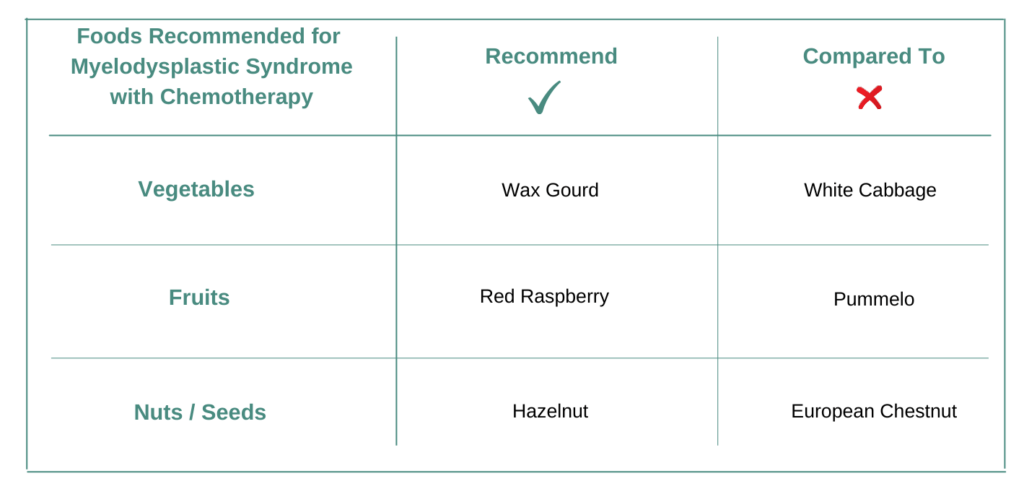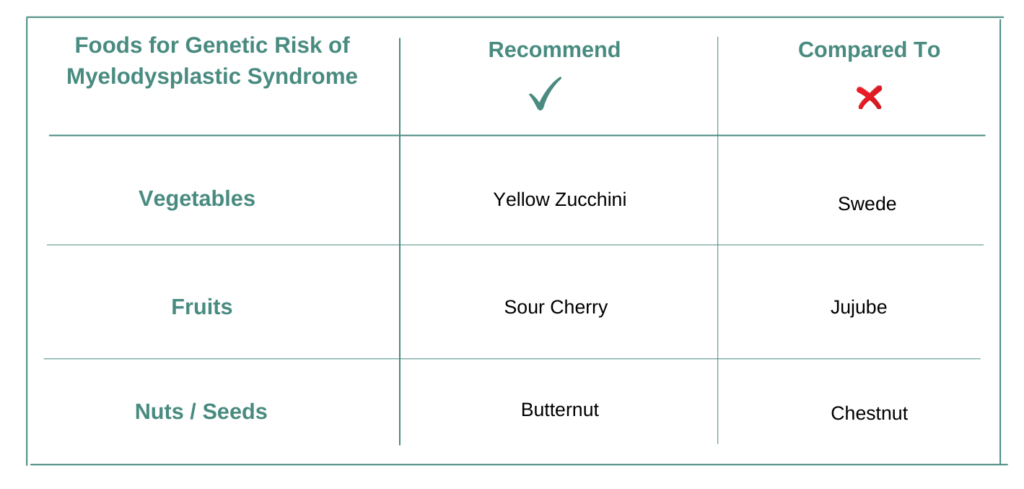Introduction
Foods for Myelodysplastic Syndrome should be personalized for each individual and also must adapt when cancer treatment or tumor genetic change. The personalization and adaptation must consider all the active ingredients or bioactives contained in different foods with respect to cancer tissue biology, genetics, treatments, lifestyle conditions and diet preferences. Hence while nutrition is one of the very important decisions for a cancer patient and individual at risk of cancer to make – how to choose foods to eat is not an easy task.
Myelodysplastic syndromes (MDS) are a group of blood cancers that affect the production of normal blood cells in the bone marrow. When the abnormal leukemia cell divides, the original mutation is preserved and it produces a clone of identical abnormal cells with the same defect, hence MDS is a clonal blood stem cell disorder. Myelodysplastic syndromes are more common in older individuals over 60 years of age and affects males slightly more than females. In MDS, the abnormal bone marrow stem cells (also called blasts) produce increased numbers of immature blood cells that often die prematurely. This results in lower numbers of mature red blood cells, white blood cells and platelets making the patient more susceptible to infections, bleeding, bruising and fatigue. MDS is classified according to the type and number of blasts in the bone marrow into 5 main subtypes: refractory anemia; refractory anemia with sideroblasts; refractory anemia with excess blasts; refractory anemia with excess blasts in transformation; and chronic myelomonocytic leukemia (CMML). People with MDS have active bone marrows but abnormally low blood cell counts. General symptoms associated with MDS include fatigue, dizziness, weakness, bruising and bleeding, frequent infections, and headaches. In some cases, MDS may progress to life-threatening failure of the bone marrow or develop into acute myeloid leukemia (AML). Treatment options for myelodysplastic syndromes include blood transfusions, growth factors such as granulocyte-colony stimulation growth factor (G-CSF), hypomethylating agents, immunomodulatory agents, and chemotherapy. In addition, supportive care with the right nutrition (foods and natural supplements) can help improve patients’ well-being.
For Myelodysplastic Syndrome does it matter what vegetables, fruits, nuts, seeds one eats?
A very common nutrition question asked by cancer patients and individuals at-genetic risk of cancer is – for cancers like Myelodysplastic Syndrome does it matter what foods I eat and which I do not? Or if I follow a plant-based diet is that enough for cancer like Myelodysplastic Syndrome?
For example does it matter if vegetable Wax Gourd is consumed more compared to White Cabbage? Does it make any difference if fruit Pummelo is preferred over Red Raspberry? Also if similar choices are made for nuts/seeds like Hazelnut over European Chestnut and for pulses like Adzuki Bean over Green Bean. And if what I eat matters – then how does one identify foods which are recommended for Myelodysplastic Syndrome and is it the same answer for everyone with the same diagnosis or genetic risk?
Yes! Foods you eat matters for Myelodysplastic Syndrome!
Food recommendations may not be the same for everyone and can be different even for the same diagnosis and genetic risk.

All foods (vegetables, fruits, nuts, seeds, pulses, oils etc.) and nutritional supplements are made up of more than one active molecular ingredient or bio-actives in different proportions and quantities. Each active ingredient has a unique mechanism of action – which can be activation or inhibition of different biochemical pathways. Simply stated foods and supplements which are recommended are those which do not cause an increase of molecular drivers of cancer but reduce them. Else those foods should not be recommended. Foods contain multiple active ingredients – hence when evaluating foods and supplements you need to consider the impact of all active ingredients cumulatively rather than individually.
For example Pummelo contains active ingredients Apigenin, Curcumin, Quercetin, Isoliquiritigenin, Lupeol. And Red Raspberry contains active ingredients Curcumin, Quercetin, Isoliquiritigenin, Ellagic Acid, Lupeol and possibly others.
A common mistake made when deciding and choosing foods to eat for Myelodysplastic Syndrome – is to evaluate only selected active ingredients contained in foods and ignore the rest. Because different active ingredients contained in foods may have opposing effects on cancer drivers – you cannot cherry pick active ingredients in foods and supplements for making a nutrition decision for Myelodysplastic Syndrome.
YES – FOOD CHOICES MATTER FOR CANCER. NUTRITION DECISIONS MUST CONSIDER ALL ACTIVE INGREDIENTS OF FOODS.
Skills Needed for Nutrition Personalization for Myelodysplastic Syndrome?
Personalized nutrition for cancers like Myelodysplastic Syndrome consists of recommended foods / supplements; not recommended foods / supplements with example recipes which prioritize use of recommended foods. An example of personalized nutrition can be seen at this link.
Deciding which foods are recommended or not is extremely complicated, requiring expertise in Myelodysplastic Syndrome biology, food science, genetics, biochemistry along with good understanding of how cancer treatments work and associated vulnerabilities by which the treatments could stop being effective.
MINIMUM KNOWLEDGE EXPERTISE NEEDED FOR NUTRITION PERSONALIZATION FOR CANCER ARE: CANCER BIOLOGY, FOOD SCIENCE, CANCER TREATMENTS AND GENETICS.
Foods to Eat After Cancer Diagnosis!
No two cancers are the same. Go beyond the common nutrition guidelines for everyone and make personalized decisions about food and supplements with confidence.
Characteristics of cancers like Myelodysplastic Syndrome
All cancers like Myelodysplastic Syndrome can be characterized by a unique set of biochemical pathways – the signature pathways of Myelodysplastic Syndrome. Biochemical pathways like Amino Acid Metabolism, Histone/Protein Acetylation, RUNX Signaling, RAS-RAF Signaling are part of the signature definition of Myelodysplastic Syndrome. Each individual’s cancer genetics can be different and hence their specific cancer signature could be unique.
The treatments which are effective for Myelodysplastic Syndrome need to be cognizant of the associated signature biochemical pathways for each cancer patient and individual at genetic risk. Therefore different treatments with different mechanisms of actions are effective for different patients. Similarly and for the same reasons foods and supplements need to be personalized for each individual. Hence some foods and supplements are recommended for Myelodysplastic Syndrome when taking cancer treatment Lenalidomide, and some foods and supplements are not recommended.
Sources like cBioPortal and many others provide population representative patient anonymized data from clinical trials for all cancer indications. This data consists of clinical trial study details like sample size / number of patients, age groups, gender, ethnicity, treatments, tumor site and any genetic mutations.
RUNX1, NSD1, JAK2, KMT2A and EP300 are the top ranked reported genes for Myelodysplastic Syndrome. RUNX1 is reported in 16.1 % of the representative patients across all clinical trials. And NSD1 is reported in 6.7 %. The combined population patient data cover ages from 24 to 86. 58.6 % of the patient data are identified as men. The Myelodysplastic Syndrome biology along with reported genetics together define the population represented signature biochemical pathways for this cancer. If the individual cancer tumor genetics or genes contributing to the risk are also known then that should also be used for nutrition personalization.
NUTRITION CHOICES SHOULD MATCH WITH EACH INDIVIDUAL’S CANCER SIGNATURE.
Food and Supplements for Myelodysplastic Syndrome
For Cancer Patients
Cancer patients on treatment or on palliative care need to make decisions on food and supplements – for the needed dietary calories, for managing any treatment side effects and also for improved cancer management. All plant-based foods are not equal and choosing and prioritizing foods which are personalized and customized to ongoing cancer treatment is important and complicated. Here are some examples providing guidelines for making nutrition decisions.
Choose Vegetable WAX GOURD or WHITE CABBAGE?
Vegetable Wax Gourd contains many active ingredients or bioactives such as Apigenin, Curcumin, Isoliquiritigenin, Luteolin, Lupeol. These active ingredients manipulate various biochemical pathways like Cell Cycle, Hypoxia, P53 Signaling and MYC Signaling and others. Wax Gourd is recommended for Myelodysplastic Syndrome when ongoing cancer treatment is Lenalidomide. This is because Wax Gourd modifies those biochemical pathways which have been scientifically reported to sensitize the effect of Lenalidomide.
Some of the active ingredients or bioactives in vegetable White Cabbage are Curcumin, Quercetin, Isoliquiritigenin, Lupeol, Kaempferol. These active ingredients manipulate various biochemical pathways like Oxidative Stress and others. White Cabbage is not recommended for Myelodysplastic Syndrome when ongoing cancer treatment is Lenalidomide because it modifies those biochemical pathways which make the cancer treatment resistant or less responsive.
VEGETABLE WAX GOURD IS RECOMMENDED OVER WHITE CABBAGE FOR Myelodysplastic Syndrome AND TREATMENT Lenalidomide.
Choose Fruit RED RASPBERRY or PUMMELO?
Fruit Red Raspberry contains many active ingredients or bioactives such as Curcumin, Quercetin, Isoliquiritigenin, Ellagic Acid, Lupeol. These active ingredients manipulate various biochemical pathways like Cell Cycle, Hypoxia, P53 Signaling and MYC Signaling and others. Red Raspberry is recommended for Myelodysplastic Syndrome when ongoing cancer treatment is Lenalidomide. This is because Red Raspberry modifies those biochemical pathways which have been scientifically reported to sensitize the effect of Lenalidomide.
Some of the active ingredients or bioactives in fruit Pummelo are Apigenin, Curcumin, Quercetin, Isoliquiritigenin, Lupeol. These active ingredients manipulate various biochemical pathways like Oxidative Stress and others. Pummelo is not recommended for Myelodysplastic Syndrome when ongoing cancer treatment is Lenalidomide because it modifies those biochemical pathways which make the cancer treatment resistant or less responsive.
FRUIT RED RASPBERRY IS RECOMMENDED OVER PUMMELO FOR Myelodysplastic Syndrome AND TREATMENT Lenalidomide.
Choose Nut HAZELNUT or EUROPEAN CHESTNUT?
Hazelnut contains many active ingredients or bioactives such as Apigenin, Curcumin, Isoliquiritigenin, Luteolin, Lupeol. These active ingredients manipulate various biochemical pathways like Cell Cycle, Histone/Protein Acetylation, P53 Signaling and Hypoxia and others. Hazelnut is recommended for Myelodysplastic Syndrome when ongoing cancer treatment is Lenalidomide. This is because Hazelnut modifies those biochemical pathways which have been scientifically reported to sensitize the effect of Lenalidomide.
Some of the active ingredients or bioactives in European Chestnut are Apigenin, Curcumin, Quercetin, Isoliquiritigenin, Ellagic Acid. These active ingredients manipulate various biochemical pathways like Oxidative Stress and others. European Chestnut is not recommended for Myelodysplastic Syndrome when ongoing cancer treatment is Lenalidomide because it modifies those biochemical pathways which make the cancer treatment resistant or less responsive.
HAZELNUT IS RECOMMENDED OVER EUROPEAN CHESTNUT FOR Myelodysplastic Syndrome AND TREATMENT Lenalidomide.

For Individuals with Genetic Risk of Cancer
The question asked by individuals who have genetic risk of Myelodysplastic Syndrome or familial history is “What Should I Eat Differently from Before?” and how they should choose foods and supplements to manage risks of the disease. Since for cancer risk there is nothing actionable in terms of treatment – decisions of foods and supplements become important and one of the very few actionable things which can be done. All plant-based foods are not equal and based on identified genetics and pathway signature – the choices of food and supplements should be personalized.
Choose Vegetable YELLOW ZUCCHINI or SWEDE?
Vegetable Yellow Zucchini contains many active ingredients or bioactives such as Curcumin, Apigenin, Formononetin, Lupeol, Phloretin. These active ingredients manipulate various biochemical pathways like TGFB Signaling, Histone/Protein Acetylation, Cell Cycle Checkpoints and MYC Signaling and others. Yellow Zucchini is recommended for risk of Myelodysplastic Syndrome when associated genetic risk is EP300. This is because Yellow Zucchini increases those biochemical pathways which counteract the signature drivers of it.
Some of the active ingredients or bioactives in vegetable Swede are Curcumin, Apigenin, Formononetin, Lupeol, Phloretin. These active ingredients manipulate various biochemical pathways like TGFB Signaling and others. Swede is not recommended when risk of Myelodysplastic Syndrome when associated genetic risk is EP300 because it increases the signature pathways of it.
VEGETABLE YELLOW ZUCCHINI IS RECOMMENDED OVER SWEDE FOR EP300 GENETIC RISK OF CANCER.
Choose Fruit SOUR CHERRY or JUJUBE?
Fruit Sour Cherry contains many active ingredients or bioactives such as Curcumin, Apigenin, Formononetin, Lupeol, Phloretin. These active ingredients manipulate various biochemical pathways like TGFB Signaling, Histone/Protein Acetylation, PI3K-AKT-MTOR Signaling and MYC Signaling and others. Sour Cherry is recommended for risk of Myelodysplastic Syndrome when associated genetic risk is EP300. This is because Sour Cherry increases those biochemical pathways which counteract the signature drivers of it.
Some of the active ingredients or bioactives in fruit Jujube are Curcumin, Apigenin, Formononetin, Lupeol, Phloretin. These active ingredients manipulate various biochemical pathways like TGFB Signaling, PI3K-AKT-MTOR Signaling and Cell Cycle Checkpoints and others. Jujube is not recommended when risk of Myelodysplastic Syndrome when associated genetic risk is EP300 because it increases the signature pathways of it.
FRUIT SOUR CHERRY IS RECOMMENDED OVER JUJUBE FOR EP300 GENETIC RISK OF CANCER.
Choose Nut BUTTERNUT or CHESTNUT?
Butternut contains many active ingredients or bioactives such as Curcumin, Apigenin, Formononetin, Lupeol, Phloretin. These active ingredients manipulate various biochemical pathways like TGFB Signaling, Histone/Protein Acetylation, Cell Cycle Checkpoints and MYC Signaling and others. Butternut is recommended for risk of Myelodysplastic Syndrome when associated genetic risk is EP300. This is because Butternut increases those biochemical pathways which counteract the signature drivers of it.
Some of the active ingredients or bioactives in Chestnut are Curcumin, Apigenin, Formononetin, Lupeol, Phloretin. These active ingredients manipulate various biochemical pathways like TGFB Signaling and Cell Cycle Checkpoints and others. Chestnut is not recommended when risk of Myelodysplastic Syndrome when associated genetic risk is EP300 because it increases the signature pathways of it.
BUTTERNUT IS RECOMMENDED OVER CHESTNUT FOR EP300 GENETIC RISK OF CANCER.

In Conclusion
Foods and Supplements chosen are important decisions for cancers like Myelodysplastic Syndrome. Myelodysplastic Syndrome patients and individuals with genetic-risk always have this question: “What foods and nutritional supplements are recommended for me and which are not?” There is a common belief which is a misconception that all plant-based foods could be beneficial or not but would not be harmful. Certain foods and supplements can interfere with cancer treatments or promote molecular pathway drivers of cancer.
There are different types of cancer indications like Myelodysplastic Syndrome, each with different tumor genetics with further genomic variations across each individual. Further every cancer treatment and chemotherapy has a unique mechanism of action. Each food like Wax Gourd contains various bioactives in different quantities, which have an impact on different and distinct sets of biochemical pathways. The definition of personalized nutrition is individualized food recommendations for the cancer indication, treatments, genetics, lifestyle and other factors. Nutrition personalization decisions for cancer require knowledge of cancer biology, food science and an understanding of different chemotherapy treatments. Finally when there are treatment changes or new genomics is identified – the nutrition personalization needs re-evaluation.
The addon nutrition personalization solution makes the decision making easy and removes all the guesswork in answering the question, “What foods should I choose or not choose for Myelodysplastic Syndrome?”. The addon multi-disciplinary team includes cancer physicians, clinical scientists, software engineers and data scientists.
Personalized Nutrition for Cancer!
Cancer changes with time. Customize and modify your nutrition based on cancer indication, treatments, lifestyle, food preferences, allergies and other factors.
References
- Mds Mskcc 2020
- Preventive effects of butyric acid, nicotinamide, calcium glucarate alone or in combination during the 7, 12-dimethylbenz (a) anthracene induced mouse skin tumorigenesis via modulation of K-Ras-PI3K-AKTpathway and associated micro RNAs.
- Formononetin suppresses the proliferation of human non-small cell lung cancer through induction of cell cycle arrest and apoptosis.
- Melatonin and vitamin D3 synergistically down-regulate Akt and MDM2 leading to TGFβ-1-dependent growth inhibition of breast cancer cells.
- In vitro and in vivo antitumor activity of neochlorogenic acid in human gastric carcinoma cells are complemented with ROS generation, loss of mitochondrial membrane potential and apoptosis induction.
- Functional lipidomics: Palmitic acid impairs hepatocellular carcinoma development by modulating membrane fluidity and glucose metabolism.
- https://rarediseases.org/rare-diseases/myelodysplastic-syndromes/#:~:text=General%20symptoms%20associated%20with%20MDS,or%20develop%20into%20acute%20leukemia.
- https://www.leukaemia.org.au/blood-cancer-information/types-of-blood-cancer/myelodysplastic-syndromes
- https://www.ncbi.nlm.nih.gov/books/NBK534126
